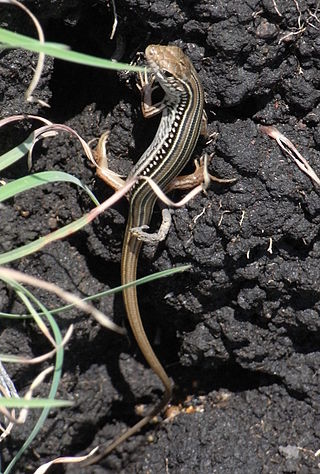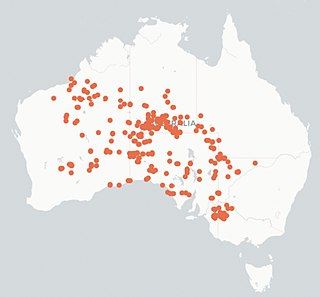- Ctenotus agrestis S. Wilson & Couper, 1995 – Mitchell grass ctenotus
- Ctenotus alacer Storr, 1970 – lively ctenotus
- Ctenotus alleni Storr, 1974 – Ajana ctenotus
- Ctenotus allotropis Storr, 1981 – brown-blazed wedgesnout ctenotus
- Ctenotus angusticeps Storr, 1988 – northwestern coastal ctenotus, little leopard ctenotus, Airlie Island ctenuous
- Ctenotus aphrodite Ingram & Czechura, 1990 – Oorida ctenotus
- Ctenotus arcanus Czechura & Wombey, 1982 – arcane ctenotus
- Ctenotus ariadnae Storr, 1969 – Ariadna's ctenotus
- Ctenotus arnhemensis Storr, 1981 – Jabiluka ctenotus
- Ctenotus astarte Czechura, 1986 – stony downs ctenotus
- Ctenotus astictus Horner, 1995 – Arnhem striped ctenotus
- Ctenotus atlas Storr, 1969 – southern mallee ctenotus
- Ctenotus australis (Gray, 1838) – western limestone ctenotus
- Ctenotus borealis Horner & King, 1985 – white-faced ctenotus
- Ctenotus brachyonyx Storr, 1971 – short-clawed ctenotus
- Ctenotus brevipes Storr, 1981 – short-footed ctenotus
- Ctenotus brooksi (Loveridge, 1933) – wedgesnout ctenotus
- Ctenotus burbidgei Storr, 1975 – plain-backed Kimberley ctenotus
- Ctenotus calurus Storr, 1969 – blue-tailed finesnout ctenotus
- Ctenotus capricorni Storr, 1981 – Capricorn ctenotus
- Ctenotus catenifer Storr, 1974 – chain-striped south-west ctenotus
- Ctenotus coggeri Sadlier, 1985 – brown-backed ctenotus
- Ctenotus colletti (Boulenger, 1896) – Collett’s skink, buff-tailed finesnout ctenotus
- Ctenotus decaneurus Storr, 1970 – ten-lined ctenotus
- Ctenotus delli Storr, 1974 – Darling Range south-west ctenotus
- Ctenotus duricola Storr, 1975 – Eastern Pilbara lined ctenotus, Pilbara ctenotus
- Ctenotus dux Storr, 1969 – fine side-lined ctenotus
- Ctenotus ehmanni Storr, 1985 – brown-tailed finesnout ctenotus
- Ctenotus essingtonii (Gray, 1842) – lowlands plain-backed ctenotus
- Ctenotus euclae Storr, 1971 – wedgesnout ctenotus
- Ctenotus eurydice Czechura & Wombey, 1982 – brown-backed yellow-lined ctenotus
- Ctenotus eutaenius Storr, 1981 – black-backed yellow-lined ctenotus
- Ctenotus fallens Storr, 1974 – West-coast laterite ctenotus
- Ctenotus gagudju Sadlier, Wombey & Braithwaite, 1986 – Magela ctenotus, Kakadu ctenotus
- Ctenotus gemmula Storr, 1974 – jewelled south-west ctenotus
- Ctenotus grandis Storr, 1969 – grand ctenotus
- Ctenotus greeri Storr, 1979 – spotted-necked ctenotus
- Ctenotus halysis Horner, 2009 – chained ctenotus
- Ctenotus hanloni Storr, 1980 – nimble ctenotus
- Ctenotus hebetior Storr, 1978 – stout ctenotus
- Ctenotus helenae Storr, 1969 – clay-soil ctenotus
- Ctenotus hilli Storr, 1970 – top-end lowlands ctenotus
- Ctenotus iapetus Storr, 1975 – North West Cape ctenotus
- Ctenotus impar Storr, 1969 – odd-striped ctenotus
- Ctenotus ingrami Czechura & Wombey, 1982 – unspotted yellow-sided ctenotus
- Ctenotus inornatus (Gray, 1845) – bar-shouldered ctenotus
- Ctenotus joanae Storr, 1970 – black-soil ctenotus
- Ctenotus kurnbudj Sadlier, Wombey & Braithwaite, 1986 – Kurnbudj ctenotus
- Ctenotus kutjupa Hutchinson, Prates & Rabosky, 2022
- Ctenotus labillardieri (A.M.C. Duméril & Bibron, 1839) – common south-west ctenotus
- Ctenotus lancelini Ford, 1969 – Lancelin Island skink, Lancelin south-west ctenotus
- Ctenotus lateralis Storr, 1978 – gravelly-soil ctenotus
- Ctenotus leae (Boulenger, 1887) – orange-tailed finesnout skink
- Ctenotus leonhardii (Sternfeld, 1919) – Leonhardi's ctenotus, Leonhardi's skink, common desert ctenotus
- Ctenotus maryani Aplin & Adams, 1998 – Maryan's ctenotus
| - Ctenotus mastigura Storr, 1975 – whiptail ctenotus
- Ctenotus mesotes Horner, 2009 – median-striped ctenotus
- Ctenotus militaris Storr, 1975 – soldier ctenotus
- Ctenotus mimetes Storr, 1969 – checker-sided ctenotus
- Ctenotus monticola Storr, 1981 – Atherton ctenotus
- Ctenotus nasutus Storr, 1969 – nasute finesnout ctenotus
- Ctenotus nigrilineatus Storr, 1990 – pin-striped finesnout ctenotus
- Ctenotus nullum Ingram & Czechura, 1990 – nullum ctenotus
- Ctenotus olympicus Hutchinson & Donnellan, 1999 – spotted ctenotus
- Ctenotus ora Kay & Keogh, 2012 – coastal plains skink
- Ctenotus orientalis Storr, 1971 – oriental ctenotus
- Ctenotus pallasotus Rabosky & Doughty, 2017 – Western Pilbara lined ctenotus
- Ctenotus pallescens Storr, 1970 – north-western wedgesnout ctenotus
- Ctenotus pantherinus (W. Peters, 1866) - leopard ctenotus
- Ctenotus piankai Storr, 1969 - course sand ctenotus
- Ctenotus pulchellus Storr, 1978 - red-sided ctenotus
- Ctenotus quattuordecimlineatus (Sternfeld, 1919) - fourteen-lined ctenotus
- Ctenotus quinkan Ingram, 1979 - Quinkan ctenotus
- Ctenotus quirinus Horner, 2007 - Arnhem land ctenotus
- Ctenotus rawlinsoni Ingram, 1979 - Cape Heath ctenotus
- Ctenotus regius Storr, 1971 - pale-rumped ctenotus
- Ctenotus rhabdotus Rabosky & Doughty, 2017 - Kimberley lined ctenotus
- Ctenotus rimacolus Horner & Fisher, 1998 - crack-dwelling ctenotus
- Ctenotus robustus Storr, 1970 - robust ctenotus, striped skink
- Ctenotus rosarium Couper, Amey & Kutt, 2002 - beaded ctenotus
- Ctenotus rubicundus Storr, 1978 - ruddy ctenotus
- Ctenotus rufescens Storr, 1979 - rufous finesnout ctenotus
- Ctenotus rutilans Storr, 1980 - rusty-shouldered ctenotus
- Ctenotus saxatilis Storr, 1970 - stony-soil ctenotus
- Ctenotus schevilli (Loveridge, 1933) - black-soil rises ctenotus
- Ctenotus schomburgkii (W. Peters, 1863) - barred wedge-snout ctenotus
- Ctenotus septenarius King, Horner & Fyfe, 1988 - massive-gibber ctenotus
- Ctenotus serotinus Czechura, 1986 - gravel-downs ctenotus
- Ctenotus serventyi Storr, 1975 - north-western sandy-loam ctenotus
- Ctenotus severus Storr, 1969 - stern ctenotus
- Ctenotus spaldingi (Macleay, 1877) - straight-browed ctenotus
- Ctenotus storri Rankin, 1978 - buff-striped ctenotus
- Ctenotus strauchii (Boulenger, 1887) - eastern barred wedge-snout ctenotus
- Ctenotus striaticeps Storr, 1978 - stripe-headed finesnout ctenotus
- Ctenotus stuarti Horner, 1995 - Stuart's ctenotus
- Ctenotus superciliaris Rabosky, Hutchinson, Donnellan, Talaba & Lovette, 2014 - sharp-browed ctenotus
- Ctenotus taeniatus (Mitchell, 1949) - eyrean ctenotus
- Ctenotus taeniolatus (White, 1790) – copper-tailed skink, copper-tailed ctenotus
- Ctenotus tanamiensis Storr, 1970 – Tanami ctenotus
- Ctenotus tantillus Storr, 1975 – Kimberley wedge-snout ctenotus
- Ctenotus terrareginae Ingram & Czechura, 1990 – Hinchinbrook ctenotus
- Ctenotus uber Storr, 1969 – spotted ctenotus
- Ctenotus vagus Horner, 2009 – uneven-striped ctenotus
- Ctenotus vertebralis Rankin & Gillam, 1979 – scant-striped ctenotus
- Ctenotus xenopleura Storr, 1981 – wide-striped ctenotus
- Ctenotus youngsoni Storr, 1975 – Shark Bay south-west ctenotus
- Ctenotus zastictus Storr, 1984 – Hamelin ctenotus, Hamelin Pool ctenotus
- Ctenotus zebrilla Storr, 1981 – Southern Cape York fine-snout ctenotus
|












